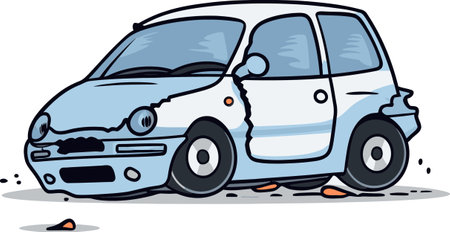Understanding the Roots of Range Anxiety
In the early days of electric vehicle adoption across the United Kingdom, a distinct sense of uncertainty pervaded British motorists. This phenomenon, known as range anxiety, is deeply intertwined with the nation’s unique driving culture and geography. Unlike the vast motorways of continental Europe or the gridlocked highways of America, the UK’s intricate network of urban streets, rural lanes, and historic byways shapes both how and where people travel. For generations, British drivers have relished the freedom to journey from quaint Cotswold villages to bustling London boroughs, often on a whim and without meticulous planning. The petrol station—ever-present and reassuring—became a symbol of this spontaneity. Yet, as electric vehicles began making their quiet entrance onto UK roads, questions arose: Would there be enough charging points in remote Scottish Highlands or along windswept Cornish coasts? Could an EV handle an impromptu trip to visit relatives up North or a weekend escape to the Lake District? These concerns were not merely technical; they tapped into cherished aspects of British life—independence, adventure, and reliability. As such, understanding range anxiety in Britain requires more than analysing battery technology; it demands an appreciation for the values and habits that have long defined the nations relationship with its roads.
2. The Current Landscape of UK Charging Networks
To truly address range anxiety, one must first explore the intricate tapestry of charging networks now woven across the United Kingdom. The British Isles have witnessed a remarkable surge in both public and private providers, each vying to power the nation’s electric revolution. From bustling cityscapes to tranquil rural retreats, the accessibility and reliability of these charging points are shaping the daily lives and travel habits of Britons.
Major Providers: A Symphony of Choice
The UK’s charging infrastructure is championed by several key players, whose distinct approaches cater to diverse needs. Public networks such as BP Pulse, Pod Point, Ionity, and ChargePlace Scotland offer comprehensive coverage, while supermarkets like Tesco and Sainsbury’s have integrated chargers into their car parks—making top-ups part of the weekly shop. In parallel, private solutions from Tesla Supercharger (now open to non-Tesla vehicles at select sites) and emerging local schemes ensure that drivers across regions never stray too far from a charge.
| Provider | Coverage Area | Key Features |
|---|---|---|
| BP Pulse | Nationwide | Rapid and ultra-fast chargers; app integration; subscription options |
| Pod Point | Urban & Retail Locations | User-friendly app; supermarket partnerships; widespread slow/fast chargers |
| Tesla Supercharger | Main Motorways & Urban Hubs | Ultra-fast charging; high reliability; now open to other brands at some locations |
| ChargePlace Scotland | Scotland-specific focus | Government-backed; extensive rural reach; no subscription fees for many points |
| Ionity | Main Arteries & Motorways | Pan-European network; ultra-rapid charging; pay-as-you-go pricing structure |
Mapping Hotspots: From London’s Heart to the Lake District’s Edge
The capital leads with dense clusters around Westminster, Canary Wharf, and tech-forward boroughs like Hackney. Yet, innovation is not confined to urban centres. The Midlands’ industrial heritage is now matched by cutting-edge charge hubs in Birmingham and Coventry. Heading north, Manchester and Leeds light up the map with rapid-charging corridors along major motorways.
No less impressive is progress in scenic regions: Cumbria’s Lake District now boasts EV chargers nestled beside village greens and heritage inns—ensuring even those escaping to nature remain within a battery’s reach of civilisation.
The Integration into Daily British Life
The evolution of these networks is quietly reshaping routines across the country. Commuters plug in while catching up on emails at motorway services; families plan day trips knowing they can top-up at National Trust car parks or local garden centres. Charging has become as British as a cup of tea—a reliable pause amid life’s daily journeys.

3. Innovations Driving Accessibility and Reliability
As the UK continues its spirited journey towards a sustainable future, the evolution of charging networks is marked by a suite of innovations designed to address the everyday concerns of British drivers. The era of range anxiety is being steadily replaced with confidence, thanks in large part to technological advancements and service refinements that are carefully attuned to British values—convenience, reliability, and trust.
Rapid Charging: Powering Journeys at Pace
The introduction of rapid charging points across motorways, city centres, and even rural outposts has been a game-changer for EV adoption in Britain. These stations can replenish an electric vehicle’s battery in as little as 30 minutes, making them perfectly suited for a nation accustomed to seamless travel and punctuality. With more than 10,000 rapid chargers now peppered across the UK, drivers can plan longer journeys with newfound assurance.
Contactless Payments: Effortless Transactions
Nothing resonates more with the British public than straightforward, hassle-free transactions. Recognising this, charging network providers have rolled out contactless payment systems at an unprecedented pace. Whether tapping a debit card or using Apple Pay, drivers can now pay for their charge without registration or membership barriers—mirroring the ease found in London’s iconic Underground or at any high street retailer.
Mobile Apps: Empowering Drivers with Real-Time Information
The modern British driver expects information at their fingertips, and mobile apps have risen to meet this demand. Leading networks offer intuitive apps that allow users to locate available chargers, check real-time status updates, reserve charging slots, and receive notifications—all while enjoying a classic cup of tea on the go. These digital companions foster transparency and empower drivers to make informed decisions, reinforcing the trust that underpins British consumer culture.
Together, these innovations form the backbone of an increasingly accessible and reliable charging infrastructure. By marrying state-of-the-art technology with quintessentially British expectations for convenience and dependability, the UK’s charging networks are not only addressing range anxiety—they are redefining what it means to drive electric on these storied isles.
4. Public and Private Partnerships: Powering Progress
In the United Kingdom, the journey to alleviate range anxiety is not a solitary pursuit; it is a collective endeavour powered by dynamic partnerships between government bodies, local councils, and esteemed British brands. These collaborations are at the heart of the nation’s evolving electric vehicle (EV) infrastructure, blending strategic vision with on-the-ground action to ensure every corner of Britain moves confidently towards an electrified future.
Government Initiatives Leading the Charge
The UK government has set ambitious targets for net zero emissions by 2050, positioning EV adoption as a linchpin in its strategy. Programmes such as the Office for Zero Emission Vehicles (OZEV) fund have provided substantial grants for both public charging points and private installations. The Rapid Charging Fund is another hallmark initiative, designed to turbocharge motorway charging hubs and address rural gaps in coverage. These policies are more than legislative gestures—they are catalysts that inspire confidence among drivers and investors alike.
Local Councils: Grassroots Innovation
Councils across England, Scotland, Wales, and Northern Ireland play a pivotal role in localising the EV revolution. From retrofitting lamp posts in London boroughs to launching community-based charging pilots in rural Scotland, councils tailor solutions to their communities’ unique needs. Their involvement ensures that no region—urban or rural—is left behind as the charging network expands.
Key Local Council Initiatives
| Council/Region | Initiative | Impact |
|---|---|---|
| London Boroughs | Lamp post chargers | Convenient kerbside access for city dwellers |
| Greater Manchester | EVCI (Electric Vehicle Charging Infrastructure) Plan | Hundreds of new charge points across the city region |
| Scottish Highlands | Community rapid charging hubs | Tackling rural range anxiety head-on |
Major British Brands: A Legacy of Collaboration
The evolution of EV infrastructure is also propelled by partnerships with British brands whose heritage is woven into the fabric of everyday life. Supermarket giants like Tesco and Sainsbury’s have partnered with leading charge point providers to install devices at retail locations nationwide, making charging as routine as the weekly shop. Energy companies—BP Pulse, Shell Recharge—and automotive icons such as Jaguar Land Rover are investing heavily in robust networks that meet modern mobility needs while honouring their storied legacies.
Collaboration in Action: A New British Standard
| Brand/Partner | Project Focus | Benefit to Drivers |
|---|---|---|
| Tesco & Pod Point | Supermarket car park chargers | Accessible charging during everyday errands |
| SSE & Scottish Government | Rural community hubs | Inclusivity across remote areas |
| Jaguar Land Rover & Plugsurfing | Pioneering premium charging experiences | Loyalty incentives and seamless journeys nationwide |
This synergy between public policy, local ingenuity, and trusted brands creates a uniquely British response to range anxiety—one that balances tradition and innovation to power progress across every shire and city.
5. Consumer Confidence: Changing Attitudes on the Road
The British relationship with motoring has always been deeply rooted in heritage, pride, and an unspoken sense of adventure. For decades, the open road represented freedom, yet the advent of electric vehicles (EVs) initially brought a wave of uncertainty—chief among them, range anxiety. However, recent years have seen a tangible shift in attitudes as robust charging networks expand across the UK, subtly transforming public perception.
Current testimonials from EV owners up and down the country illustrate a newfound confidence. Where once conversations centred around “Will I make it to Cornwall without stopping?” or “Is there a charger near my favourite Lake District hideaway?”, now there is a chorus of reassurance. Drivers recount seamless journeys along the M1 or picturesque detours through Cotswold lanes, made possible by readily available charging points at service stations, supermarkets, and even historic inns.
This evolution is closely entwined with the influence of legacy British motoring brands embracing electrification. Names like Jaguar, MINI, and Bentley—once synonymous with roaring engines and classic design—now champion sustainability without sacrificing their storied character. Their entry into the EV market has not only elevated trust but also tapped into a sense of national pride; if these icons can go electric, so too can we.
Industry surveys reflect this cultural transition: Britons are increasingly likely to view EVs as not just practical but aspirational. The anxiety that once accompanied long-distance travel is steadily being replaced by anticipation for a new era of motoring adventures. With every mile of new charging infrastructure laid—from bustling London boroughs to windswept Highland roads—the scepticism of yesteryear gives way to optimism.
Ultimately, as the narrative shifts from limitation to liberation, British drivers are rediscovering their love affair with the road—only this time, it’s powered by electricity and underpinned by a growing network that keeps anxieties firmly in the rear-view mirror.
6. Looking Ahead: The Future of EV Charging in the UK
As we peer into the horizon of British motoring, the future of EV charging stands as a beacon for the nation’s sustainable ambitions. The evolution of charging networks is set to accelerate, fuelled by both public and private investment and driven by a distinctly British spirit of innovation. Experts forecast a substantial rise in ultra-rapid chargers, with smart grids and energy storage solutions poised to become the backbone of an ever-more reliable infrastructure.
The Role of British Innovation
British ingenuity has always been at the heart of transformative progress—from steam engines to silicon chips—and today it is propelling the UK’s charging networks forward. Homegrown start-ups and established giants alike are pioneering advancements such as contactless payment systems, integrated app-based wayfinding, and seamless interoperability across providers. The government’s commitment to supporting research and development ensures that local solutions are tailored to unique British needs, whether it’s city commuters or rural explorers.
Towards a Greener Motoring Legacy
The journey towards net zero emissions is not merely about technology; it’s about reshaping the cultural landscape of mobility. As charging becomes more accessible and convenient, range anxiety will continue to fade into memory—much like red telephone boxes becoming icons of a bygone era. The integration of renewable energy sources into charging networks will further cement Britain’s reputation as a pioneer in green transport, ensuring that every mile travelled is a step towards a cleaner future.
A Nation on the Move
Ultimately, the story of EV charging in the UK is one of progress rooted in tradition yet reaching for tomorrow. With robust infrastructure, innovative minds, and steadfast commitment, Britain is steering confidently towards a new chapter in its motoring history—one where sustainability and convenience go hand in hand. For drivers across England, Scotland, Wales, and Northern Ireland, the open road has never looked so promising.


